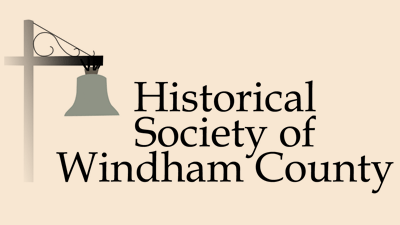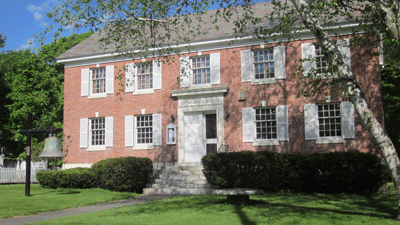Royal Charters and Land Grants
In colonial New England, the king of England appointed governors to his various royal provinces and ruled through them. They had the authority to grant, in his name, any unchartered land in their province, but this could be complicated when the land to be settled was unsurveyed wilderness, and the province borders uncertain.
The earliest grant in what would become Vermont was land in the future town of Vernon, included in the 1672 township of Squakheag (later Northfield MA). A further deed “…….covering (this) grant was made August 13th, 1687 by…..Indians of the place, in consideration of 200 fathoms of Wampum and 57 value of trading goods” (1). In 1736, Massachusetts granted another section of future Vernon, and it was here that Sartwell’s and Bridgman’s fortified settlements were built around 1740.
The year 1740 is an important date and will be returned to later, but first it is necessary to backtrack to another early land sale. In its eagerness to found new towns, the province of Massachusetts had exceeded its bounds. In 1713, in settlement of various disputes, Massachusetts agreed to cede to Connecticut 107,793 acres of equivalent lands. These lands were then sold by Connecticut in 1716 “one of the portions, containing 43,943 acres, being the present towns of Putney, Dummerston and Brattleboro” (2).
Unfortunately for the aspiring settlers of these newly acquired backwoods, “….the whole of this tract of county had previously, from time immemorial, been in the possession of the native Indians” (3), the Abenaki, who wanted to keep their land and were prepared to fight for it. Until the end of the French and Indian Wars, the Abenaki presented a formidable obstacle to settlement.
In recognition of the threat posed to their frontier, the Massachusetts authorities voted to build a defensive “….blockhouse above Northfield, in the most convenient place on the lands called the equivalent lands” (4). By the summer of 1724, Fort Dummer was ready for habitation. It was used as a base for “…scouting and punitive expeditions into Abenaki country” (5) during times of war, and as a trading post during times of peace. John Sargent arrived at the Fort with his family around 1730, followed by a few others. Another handful of frontiersman tried to develop settlements along the Connecticut River at Westminster (chartered by Massachusetts in 1735 as Township Number One) and Rockingham (under possible charters as Number Two or Fallstown or Goldenstown). Around 1740, fortified settlements were started on Fort hill on the Putney Great Meadows of the equivalent lands, and, as already mentioned, in Hinsdale/Vernon. All but Fort Sartwell were abandoned or destroyed during the King George’s War of 1744-1748, and many of the inhabitants killed or taken captive.
But to return to 1740. On March 5th, King George II ordered a survey to settle a north/south boundary dispute between Massachusetts and New Hampshire. Upon its completion, Fort Dummer was found to be in New Hampshire, whose governor was Benning Wentworth. Despite an inconclusive correspondence with the governor of New York over their respective east/west border, and the decision to refer the question to the crown, Benning Wentworth took the 1741 survey results as recognition of his jurisdiction over the lands to the west of the Connecticut River. With the ending of the King George’s War, he went to work issuing Royal Charters to this land, starting with Bennington in the far south-western corner. In 1750, his second Vermont charter went to Halifax, his third in 1751 to Marlboro, followed by one to Wilmington. In 1752, the previous Massachusetts Township Number One, now abandoned, was regranted as Westminster, and the possible Township Number Two to the north was granted as Rockingham.
According to Child’s Gazetteer “…Wentworth was interested in the settlement of Rockingham on account of the excellent masting for ships obtained in this section, and came here personally to make examination and to take measures for better securing the masting trees from being cut and felled, as they had, by charter, been secured for the masting of His Majesty’s navy”.
In 1753, Governor Wentworth was particularly busy. The equivalent lands together with the other lands were divided into townships of Fulham (later Dummerston), Putney and Brattleboro; Vernon was “confirmed to the proprietors”, and Fane and Townshend were chartered. As were Grafton and Guilford in 1754. And then all this activity was brought to a halt by the outbreak of the final French and Indian War.
The towns where some settlement had preceded the New Hampshire charters, Westminster, Putney, Brattleboro and Vernon, were again disrupted by Indian attacks. The other towns either had their charters extended, or forfeited and reissued after the war’s end in 1760, because of the impossibility of compliance in the face of Indian hostility. But then the earlier hindrance worked to the advantage of the settlers for “…in their expeditions against the French, the English colonists had made themselves acquainted with the fertility and the value of the lands lying between the Connecticut River and Lake Champlain, and the conquest of Canada having now removed the difficulty and the danger of settling them, swarms of adventurers began to migrate hither, and from the year 1760, the population of Vermont began to increase with considerable rapidity” (6).
This is not the end of the complicated story of the New Hampshire land grants. In 1764, King George III ruled in favor of New York in its east/west dispute with New Hampshire. With the Connecticut River declared the border, New York’s’ governor began issuing his own charters to the New Hampshire Grants, which were now considered part of Cumberland County, New York. The resulting period of turmoil played out differently in each town, with some accepting New York’s authority and others refusing it.
In 1777, Vermont declared itself an independent state with a constitution that prohibited slavery. In 1791, Vermont was admitted to the Union as the 14th state and grants to all remaining lands were made by the Vermont General Assembly.
1 Hemenway Vermont Gazeteer vol. 5, 1891
2 Child’s Windham County Gazeteer 1884
3 Thompson’s History of Vermont 1842
4 Child’s Windham County Gazeteer 1884
5 Calloway Western Abenaki of Vermont 1600-1800, 1900
6 Thompson’s History of Vermont 1842
The Abenaki and Resisitance to Settlement
In 1600 as many as 10,000 western Anenaki inhabited modern day Vermont and New Hampshire, depending on seasonal hunting and fishing, gathering and some agriculture.
Even before the movement of colonial settlers up the Connecticut River Valley, Native American life has been seriously destabilized by contact with the Europeans. Among many consequences were exposure to epidemic diseases which decimated the population, the various exploitations of the fur trade and cultural dislocation. For instance, warfare between the Sokokis and the Mohawks in the early 1600s disrupted life at Squashing (near present day Northfield).
The Abenaki were prepared to trade with the English, but whenever war broke out they (either alone or in alliance with the French) took the opportunity to attack and try to destroy the encroaching settlements that threatened their way of life.
Soldiers sent out against the Abenaki raiders were not at all effective. In his diary, Captain Melvin describes one scouting party that left Fort Dummer on May 13th, 1748. He and his 18 men traveled to Lake Champlain, where, on May 25th, they “…fired upon Indians…. About a mile from Crown Point, retreated east….” towards Otter Creek. After 5 days of marching about 15 miles a day, they “…came upon a branch of West River traveled down the river about 8 miles and camped.”
May 31: Our provisions being very short we began our march before sunrise and traveled about after 9 o’clock, being by the side of the river several of the company desired to stop to refresh themselves being faint and weary, whereupon we halted and began to take off our packs and some were set down and in about a half a minute after our halting the enemy rose about 12 guns at us, but do not know whether any man received any hurt, tho’ so near; whereupon I called the men to face the enemy and run up the bank, which did myself, and several others attempted, but the enemy was so thick, they could not. I was no sooner jumped up the bank but the enemy were just upon me. I discharged my gun at one of them, about eight feet from the muzzle of my gun, who I did see fall, and about the same time that I discharged my gun, the enemy fired about 20 guns at us and killed 4 men namely John Howard, Isaac Taylor, John Dod and Daniel Man. The men which were alive most of them fired immediately on the enemy, several of which shots did execution, as can be witnessed by several who see the enemy fall; but seeing the enemy numerous and their guns being discharged, they retreated. Several ran up the river, and some down, and some into a thicket on the same side of the river. For my own part, after I saw my men retreat and being beset by the enemy with guns, hatchets and knives. Several of them attempted to strike me with their hatchets. Some threw their hatchets one of which, or a bullet I cannot certainly tell which, carried away my belt and with it my bullets, all except one I had loose in my pocket. I ran down the river, and two Indians followed me, and ran almost side by side with me calling to me `Come Captain’ `Now Captain’ but upon my presenting my gun towards them (although not charged) they fell a little back, and I ran across the river, charged my gun, moved a few steps, and one of them fired at me, which was the last gun fired. I looked back and saw nine of the enemy scalping the dead men, and six or seven running across the river, and several about the bank of the river very busy, which I apprehended were carrying off their dead. I then being alone got to the side of a hill, in sight of the place of the battle, and there seated myself to look for some of my men, and to see if the enemy made any shout as is customary with them when they get the advantage but hearing no more of them, nor seeing any of my men, I made the best way back to Fort Dummer where I arrived the next day before noon, where one of my men got in about an hour before me, and eleven more came in, in a few hours though in several companys. Joseph Petty was wounded, and I have not yet heard of him.
Samuel Severns I imagine is taken. I went the next day with a above forty men to bury the dead, and spent one day looking for Joseph Petty, who was wounded, but could not find him.”
From Melvin’s Journal: N.H. Historical Collection, vol. 5, pp 109-111

